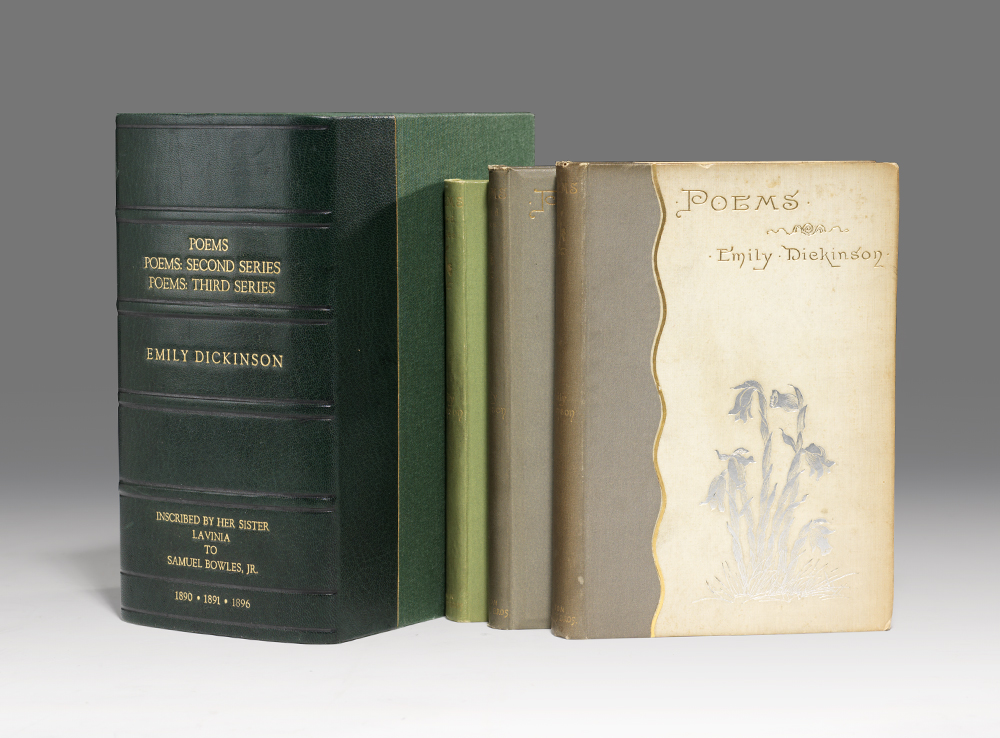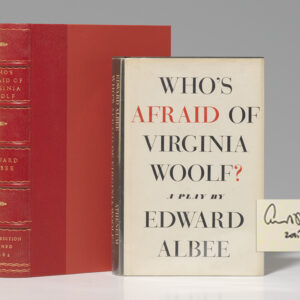Description
“ACCEPT MORE OF EMILY WITH THE FRIENDSHIP OF LAVINIA…”: RARE FIRST EDITIONS OF EMILY DICKINSON’S FIRST THREE BOOKS OF POETRY, EXTRAORDINARY ASSOCIATION PRESENTATION COPIES, INSCRIBED FROM DICKINSON’S SISTER, WHO DISCOVERED THE MANUSCRIPTS, TO THE SON OF THE POET’S INTIMATE FRIEND
DICKINSON, Emily. A collection of first editions: Poems. [First Series]. WITH: Poems. Second Series. WITH: Poems. Third Series. Boston: Roberts Brothers, 1890, 1891, 1896. Together, three volumes. 12mo, First Series in original gilt- and silver-stamped ivory boards, grey cloth spine, top edge gilt; Second Series in original gilt-stamped ivory boards, green cloth spine, all edges gilt; Third Series in original gilt-stamped gray cloth, top edge gilt. Housed together in a custom clamshell box and half morocco slipcase.
Extraordinary Emily Dickinson collection, consisting of the rare first editions, first printings of the first three books of her poetry, exceptionally important presentation association copies, each inscribed by Emily’s sister Lavinia, who discovered the manuscripts, to Samuel Bowles, son of one of her close friends and publishers.
Each of these copies is inscribed by Dickinson’s sister Lavinia to the younger Samuel Bowles, who assumed editorship of the Republican upon his father’s death in 1878. Poems is inscribed and dated four days before publication, “Samuel Bowles from his friend Lavinia Dickinson, November 8th 1890”; Second Series is inscribed “Nice Mr. Bowles Accept More of Emily with the Friendship of Lavinia”; Third Series is inscribed “Our dear Samuel Bowles September 96,” and includes a laid-in card inscribed ““Uncle S.B. and Aunt Beth with love from” Mr. Roger Sherman Hoar [printed name]. Emily Dickinson published only 11 poems during her lifetime, six of them in Samuel Bowles’ newspaper, the Springfield Republican. After her death in 1886, her sister Lavinia discovered a locked box containing 1,775 manuscript poems. Mabel Todd edited and published the three series of these poems until a quarrel between the Dickinson and the Todd families led to a division of the manuscripts, preventing the publication of complete and authoritative editions of Dickinson’s poetry until 70 years after her death. The elder Bowles was one of Dickinson’s closest friends, a recipient of nearly 50 of her poems during her lifetime. He and his family were intimately involved in the complex relationships of the extended Dickinson clan in Amherst. It has frequently been suggested that Bowles was the intended recipient of the famously passionate and mysterious “Master” letters; certainly Dickinson “was deeply in love with him for several years and never ceased loving him, at a distance, for the rest of her life,” despite the fact that the married Bowles “was out of her reach in every way, professionally, domestically, morally” (Sewell, Life of Emily Dickinson, 473). In a letter of 1882 to the younger Bowles, Dickinson wrote “A tree your father gave me bore this priceless flower. Would you accept it because of him— Who abdicated ambush And went the way of dusk, And now against his subtle name There stands an asterisk As confident of him as we— Impregnable we are— The whole of Immortality Secreted in a star.” (Letters, 348). Yet the elder Bowles never understood Dickinson’s poetic genius—he saw fit to print only six of her poems, all anonymously, and all with added titles and alterations. In contrast, Lavinia was one of the few who unquestioningly believed in Emily’s poetic talent. It was only through her untiring effort that the poems were finally published. Dickinson’s poems are her “‘letter to the world,’ records of the life about her, of tiny ecstasies set in motion by mutations of the seasons or by home and garden incidents, of candid insights into her own states of consciousness, and of speculations on the timeless mysteries of love and death. Her mind was charged with paradox, as though her vision, like the eyes of birds, was focused in opposite direction on the two worlds of material and immaterial values. She could express feelings of deepest poignancy in terms of wit… her artistry in the modulation of simple meters and the delicate management of imperfect rhymes was greater than [Emerson’s]” (Hart, 108-9). Each book is a first printing; the First Series is in binding B (the prepublication inscription suggests that Myerson’s ordering of bindings may be incorrect), Second Series in binding B and Third Series in binding A (no priority established in Second and Third Series). Myerson A1.1a, A2.1a, A4.1. BAL 4655, 4656, 4661. Grolier American 100, 91.
In extraordinary condition, with only the most minor wear to spine ends. A superb presentation set, a peerless association, arguably the most important to be offered.



